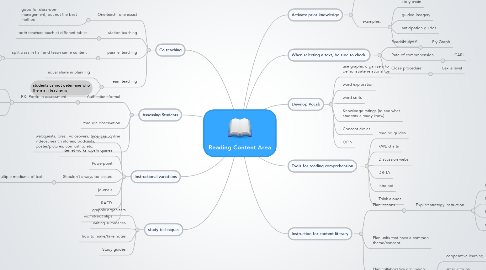
1. Assessing Students
1.1. Authentic/informal
1.1.1. EX: Portfolio assessment
1.1.1.1. checklists
1.1.1.2. student work examples
1.1.1.3. self-assessments
1.2. through observation
1.3. webquests, prezi, voiceovers, timelines, online videos, search stories, podcasts, poster/pictures, comicstrip, etc.
2. Instructional variations
2.1. blogs/wikis
2.2. internet workshops/inquiries
2.3. Powerpoint
2.4. Shouldn't always be lecture
2.4.1. include multiple mediums of text
2.5. journals
2.6. RAFTs
2.7. Admit/exit slips
3. study techniques
3.1. graphic organizers
3.2. writing summaries
3.3. how to make/take notes
3.4. Study guides
4. Co-teaching
4.1. One-teach, one assist
4.1.1. good for classroom management, but not the best method
4.2. station teaching
4.2.1. both teachers teach at different tables
4.3. parallel teaching
4.3.1. split class in half and teach same content
4.3.1.1. a) same format
4.3.1.2. b) different
4.4. Team teaching
4.4.1. equal share in planning
4.4.2. students cannot determine who the main teacher is
5. When selecting a text, be sure to check:
5.1. Readability
5.1.1. Fry Graph
5.2. Rate of comprehension
5.2.1. CARI
5.3. Cloze procedure
5.3.1. Lexile level
6. Instruction for content literacy
6.1. Plan lessons
6.1.1. Explicit strategy instruction
6.1.1.1. Crate Awareness
6.1.1.2. Model and demonstrate
6.1.1.3. Practice
6.1.1.4. Apply
6.2. Plan units that have a common theme/concept
6.3. Plan collaborative groupwork
6.3.1. cooperative learning
6.3.2. small groups
6.3.3. discussion groups
7. Activate prior knowledge
7.1. Arouse curiosity
7.1.1. Generate questions
7.1.1.1. make predictions
7.2. examples:
7.2.1. story chain
7.2.2. guided imagery
7.2.3. anticipation guides
7.2.4. ReQuest
